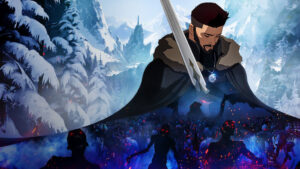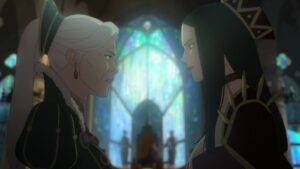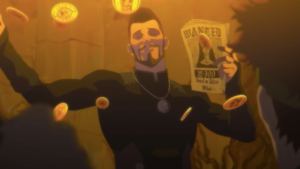SPOILERS FOR WHAT IF…? AHEAD!
Although What If…? hasn’t ignited the same level of heated discourse or enthusiastic speculation as any of Marvel’s live-action Disney+ series’ (a sad testament to the fact that animation is still viewed by many fans as somehow inherently less canon), last Wednesday’s episode had become the subject of intense scrutiny after it became widely known that it would focus on the character of Doctor Stephen Strange…specifically, a dark and twisted version of him who goes by the title of Doctor Strange Supreme (Benedict Cumberbatch).

This was largely because, coming off the first trailer for Spider-Man: No Way Home, one of many theories given for Marvel’s inconsistent characterization of Strange was that the Master of Mystic Arts had somehow been replaced by an evil doppelgänger from the Multiverse (or by Mephisto; yep, we’re doing that again). It’s a good theory: as a Doctor Strange fan baffled by some of his actions in the No Way Home trailer, I really like it. And then lo and behold, here comes What If…? with an entire episode built upon that very concept.
Now having seen the episode in question…yeah, I’m pretty sure this is another WandaVision situation where we played ourselves. I still love the evil Doctor Strange theory, mind you, and I’m not writing it off until we see how Doctor Strange Supreme’s character arc continues across What If…? season one, but I don’t know if there’s any real connection to No Way Home. And that’s okay, because like the WandaVision finale, What If…? episode four is great storytelling first and foremost.
Some of that is perhaps attributable to length: this episode is the longest of the four by a minute or two, and it enjoys a steady pacing that feels urgent without becoming frantic. But what sets it apart from the rest of What If…?, and elevates it to a place alongside WandaVision and the most sophisticated episodes of Loki and The Falcon And The Winter Soldier, is the mature tone it’s able to capture. The episode earns and owns its darkest moments with a forcefulness that was once severely lacking from the franchise, and a sensitivity that evolves from WandaVision‘s nuanced handling of discussions about death and grief.
Usually, it’s Star Wars that’s not afraid to get bleak and depressing, even in their animated shows aimed (at least initially) at kids. But watching Doctor Strange Supreme lose his sanity, his soul, his loved ones, and ultimately his entire universe in a desperate attempt to cheat death that ends with him trapped in the crystallized remnants of what was once a timeline, begging What If…?‘s dispassionate narrator The Watcher (voiced by Jeffrey Wright) for mercy, demonstrates quite powerfully that having an anthology of self-contained short stories in which to explore risky ideas can only be a good thing creatively.
The episode doesn’t even wait that long to go fully dark. The Nexus Event that kicks off Doctor Strange Supreme’s alternate timeline is the death of his girlfriend, Doctor Christine Palmer (Rachel McAdams), in the first few minutes. It’s admittedly an odd change, given that it relies so heavily on a chemistry between the two that was…never really there in Doctor Strange, but in this timeline apparently Strange really loves Palmer. The two surgeons are therefore on their way to a romantic dinner date when Strange’s car goes flying off a cliff – but in this timeline, Strange is miraculously unscathed and Palmer dies.
At first, this change doesn’t appear to have major ramifications: Doctor Strange still becomes a sorcerer and fights Dormammu (and somehow still survives that astral plane battle in the hospital where Christine saved his life in the original movie). It’s only when he gets his hands on the Time Stone that things take a turn for the worse, as Strange tries to revisit the moment of Palmer’s death and reverse it, only to discover that no matter what he changes in the past, all he does is weaken the integrity of his own universe. Christine still dies, over and over and over again.
And at a certain point, it starts to get really uncomfortable. Christine dies multiple times in the car crash, even when Strange has her drive. She dies of food poisoning the one time they actually make it to their destination. She gets shot dead in a pizza parlor when Strange picks a different location for their date. She dies in a random fire the one time he tries to abandon her for her own sake. It’s a lot, honestly. And maybe if Christine were actually a three-dimensional character, it wouldn’t be so questionable, but neither live-action nor animation did a very good job of fleshing out her personality and interests.
The problem only grows exponentially worse when the Ancient One (Tilda Swinton) explains that Christine has to die…in order for Strange to become a sorcerer. It’s a textbook example of “fridging” – killing a female character solely to motivate a male character. There’s no attempt to subvert this trope, or even to comment on it. If anything, it only opens a frightening new can of worms because the Ancient One suggests that the universe itself needs Christine to die for Strange to rise. The Nexus Event caused by her death is referred to as an Absolute Point in Time that cannot be changed or undone without destroying the universe, and it’s left somewhat unclear why that is.

Because if the whole point of Christine dying is to make sure Strange becomes a sorcerer, then it really shouldn’t matter how he gets to that point – just like it doesn’t seem to matter how Christine dies, only that she does die. I can totally get behind the idea that Doctor Strange is such a powerful mystic force that he (or some version of him) needs to exist in every universe and timeline; I don’t fully understand why his journey need be written in stone, especially since we know that other universes don’t require Christine’s death. Doesn’t that also throw out everything Sylvie and Loki did in the name of restoring free will to the Multiverse?
Interestingly, if Doctor Strange is so powerful that his universe literally balances upon him, that suggests he could be one of the MCU’s “Nexus Beings”, a group of characters in the comics who are considered the cornerstones of their respective timelines. Doctor Strange hasn’t been portrayed as a Nexus Being in the comics, but What If…? indicates that his power and influence puts him right up there alongside Kang the Conqueror, Vision, and the Scarlet Witch, all of whom are Nexus Beings in the comics and most likely in the MCU as well.
On that note, What If…? just might answer the burning question of what Scarlet Witch will be up to when we next meet her, in Doctor Strange And The Multiverse Of Madness. You’ll remember that Wanda Maximoff’s transformation into the Scarlet Witch during the WandaVision finale required her to absorb a large part of Agatha Harkness’ own magic and life-force into herself, weakening Agatha to the point of exhaustion. At the time, it seemed like a fairly simple way to incapacitate the witch. But What If…? reveals that power absorption has side effects, both good and bad. Mostly bad.
In the latest episode, Doctor Strange Supreme’s mission to bring back Christine leads him to the lost library of the ancient sorcerer Cagliostro, who was apparently one of the few people capable of undoing an Absolute Point in Time…but only by absorbing the powers of even greater mystical entities. Strange’s attempts to master this technique are not without some success (he gains the power he seeks, even if ultimately his universe implodes before he can spend more than a few moments with the resurrected Christine), but the experience transforms him into a horrible monster as he takes on the attributes of each creature he absorbs into his body: whether that’s a dragon, or the tentacled beast from episode one, or something that looks an awful lot like Mephisto.
It wasn’t until I rewatched the episode that I noticed the similarities to how Wanda’s first attempt at absorption also transformed her, albeit into a high-fashion sorceress rather than a grotesque demon. And that’s when I realized: if anyone in the main MCU timeline has reason to want to reverse an Absolute Point in Time, it’s Wanda. With the power she could gain from harvesting magical and cosmic forces far greater than herself, she could permanently undo the pain she’s experienced, and that her makeshift family suffered. She could even bring back her twin sons, whose voices she heard crying out to her in the WandaVision post-credits scene.
But first, she’d have to absorb a couple more beings – or perhaps, entire timelines and universes full of them. Good thing there’s an entire Multiverse gourmet buffet to choose from now, am I right? Maybe the demons and dark forces we once thought would be manipulating Wanda really ought to watch their backs because she could be coming to devour them. Though of course, the more powerful that Wanda grows, the more other entities will want to absorb her in turn…entities like, say, Mephisto. The possibilities are endlessly exciting, and I love how the MCU’s mystical side is developing its own complex ecosystem and food-chain.

Doctor Strange Supreme’s journey in What If…?, however, acts as a cautionary tale for anyone trying to obtain that kind of ultimate power. Consumed in his personal agenda, he neglects his duties to his universe and allows it to rot and die. He does bring back Christine, but she returns only to witness the end of all things as Strange Supreme’s timeline finally collapses, leaving him trapped in a purple orb. Strange Supreme will likely return in What If…?, but it’s still unclear how he’ll be rescued from his prison, or who would want to do so anyway. My best guess is that at some point, The Watcher will finally break his no-interference policy to save the Multiverse from an interdimensional threat, bringing several timelines together so that a new team of Avengers can form.
But for now, we leave Strange Supreme right where he deserves to be – and with the tone and atmosphere of What If…? altered irrevocably by his tragic ending, I can’t wait to see what dark and ominous tale of suspense comes next.
Episode Rating: 9.5/10








